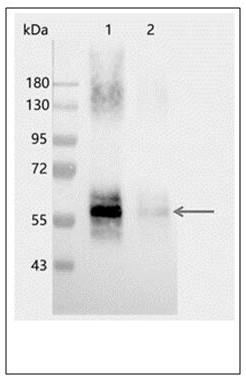Plant light system I polyclonal antibody and preparation method thereof
A polyclonal antibody and photosystem technology, applied in plant peptides, chemical instruments and methods, anti-plant immunoglobulin, etc., can solve problems such as time-consuming and laborious, hindering in-depth research of photosystem I, and many cross-reactions
- Summary
- Abstract
- Description
- Claims
- Application Information
AI Technical Summary
Problems solved by technology
Method used
Image
Examples
Embodiment 1
[0044] Example 1: Antigen epitope design
[0045]Using antheprot software, according to the Arabidopsis photosystem I protein sequence (ATCG00350 / PsaA, ATCG00340 / PsaB, ATCG01060 / PsaC, AT1G03130 / PsaD, AT4G28750 / PsaD, AT1G31330 / PsaF, AT1G55670 / PsaG, AT3G1614 published by www.arabidopsis.org / PsaH, ATCG00630 / PsaJ, AT1G30380 / PsaK, AT4G12800 / PsaL, AT5G64040 / PsaN, AT1G08380 / PsaO) for photosystem I PsaA protein, PsaB protein, PsaC protein, PsaD protein, PsaE protein, PsaF protein, PsaG protein, PsaH protein, PsaJ protein, PsaK protein, PsaL protein, PsaN protein, and PsaO protein for sequence analysis, including transmembrane distinction, signal peptide analysis, modification site analysis, and full sequence analysis to find out possible epitopes, and Cysteine is added to the end of the sequence that does not contain cysteine in the above antigen epitopes, such as PsaA, PsaD, PsaE, PsaG, PsaJ, and PsaO.
[0046] Finally select the epitope as described in Table 1:
[0047] Table...
Embodiment 2
[0050] Example 2: Preparation of polyclonal antibody
[0051] Animals for Immunization Select healthy male New Zealand white rabbits aged 3 months, weighing 2.5±0.1 kg, and immunize them with the antigen prepared in Example 1.
[0052] Before the first immunization, blood was taken from the ear vein as a negative control. The antigen was washed with PBS (137mM NaCl, 2.7mM KCl, 10mM NaCl 2 HPO 4 , 2mM KH 2 PO 4 , pH7.4) diluted to 1mg / mL, aliquoted and stored at -20°C. Take 500 μL of 1 mg / mL antigen (0.5 mg), add 300 μL PBS to dilute again, and then add an equal volume of Freund’s complete adjuvant (first immunization) or Freund’s incomplete adjuvant (2nd to 4th immunization). Multi-point injections were performed subcutaneously on the limbs, underarms and back of rabbits, and the second immunization was performed three weeks after the first immunization, and then boosted every two weeks (a total of 4 immunizations). Seven days after the third immunization, the ear Take b...
Embodiment 3
[0055] Embodiment 3: ELISA serum titer determination
[0056] Experimental reagents: 0.01M PBS (pH 7.4); coating solution (0.1mol / L Na 2 CO 3 -NaHCO 3 buffer, pH9.6), adjust the pH value with concentrated HCl; Tween-20; enzyme-labeled secondary antibody (HRP-GAR IgG); absolute ethanol; 0.03%H 2 o 2 ;2mol / LH 2 SO 4 solution; acetate buffer (pH 5.8-6.0); antigen (coated polypeptide).
[0057] Steps:
[0058] Coating antigen: Dilute the antigen to 5 µg / ml with ELISA coating solution (i.e. 1ml ELISA coating solution + 5ul 1mg / ml polypeptide mix well), add 100µl to each well, incubate overnight at 4°C or in a 37°C incubator for 2hr ;
[0059] Washing solution: wash wells with 0.01 mol / L PBS-0.05% Tween-20 solution 3 times on a plate washer, and pat dry;
[0060] Sealed microtiter plate: Add 200µl of 3% skimmed milk / 0.01M PBS to each well, block at 37°C for 1hr; (3% skimmed milk / 0.01MPBS: 1.5g skimmed milk powder + 50ml 0.01M PBS fully dissolved - two plates);
[0061] Was...
PUM
| Property | Measurement | Unit |
|---|---|---|
| pore size | aaaaa | aaaaa |
Abstract
Description
Claims
Application Information
 Login to View More
Login to View More - R&D Engineer
- R&D Manager
- IP Professional
- Industry Leading Data Capabilities
- Powerful AI technology
- Patent DNA Extraction
Browse by: Latest US Patents, China's latest patents, Technical Efficacy Thesaurus, Application Domain, Technology Topic, Popular Technical Reports.
© 2024 PatSnap. All rights reserved.Legal|Privacy policy|Modern Slavery Act Transparency Statement|Sitemap|About US| Contact US: help@patsnap.com










